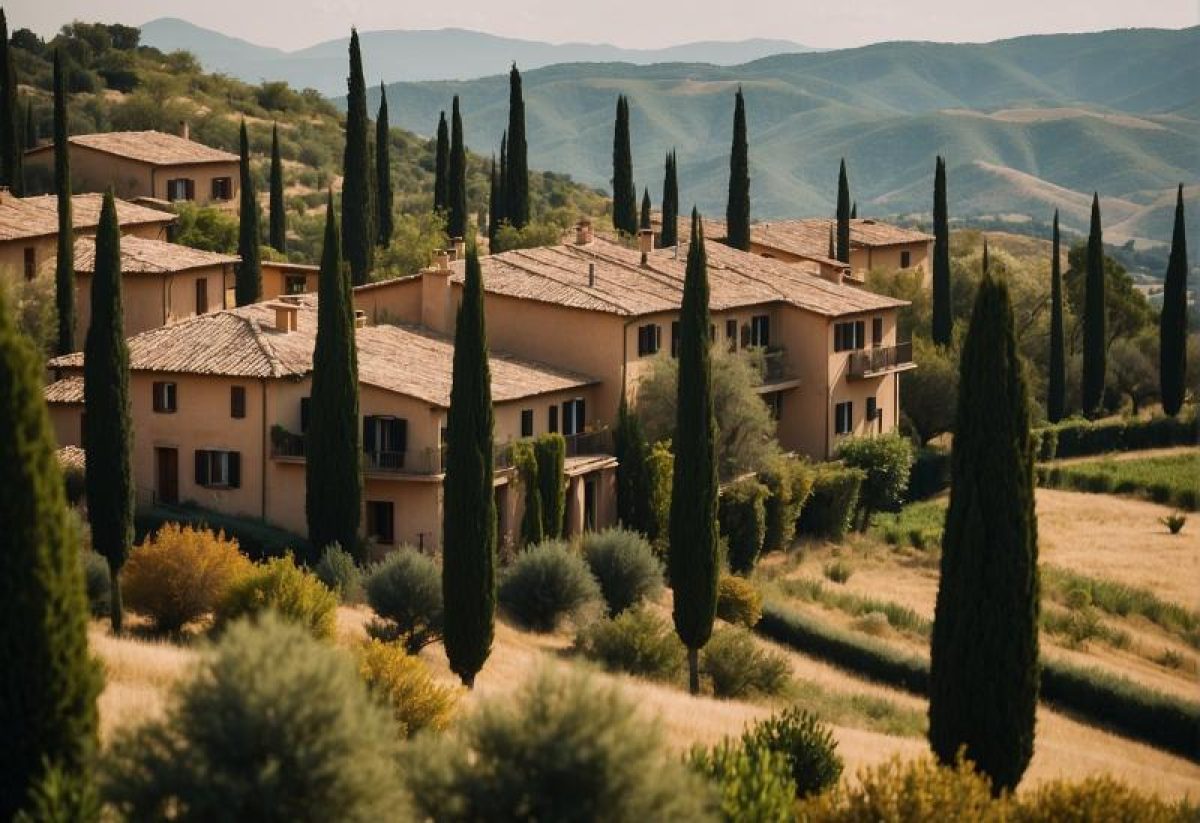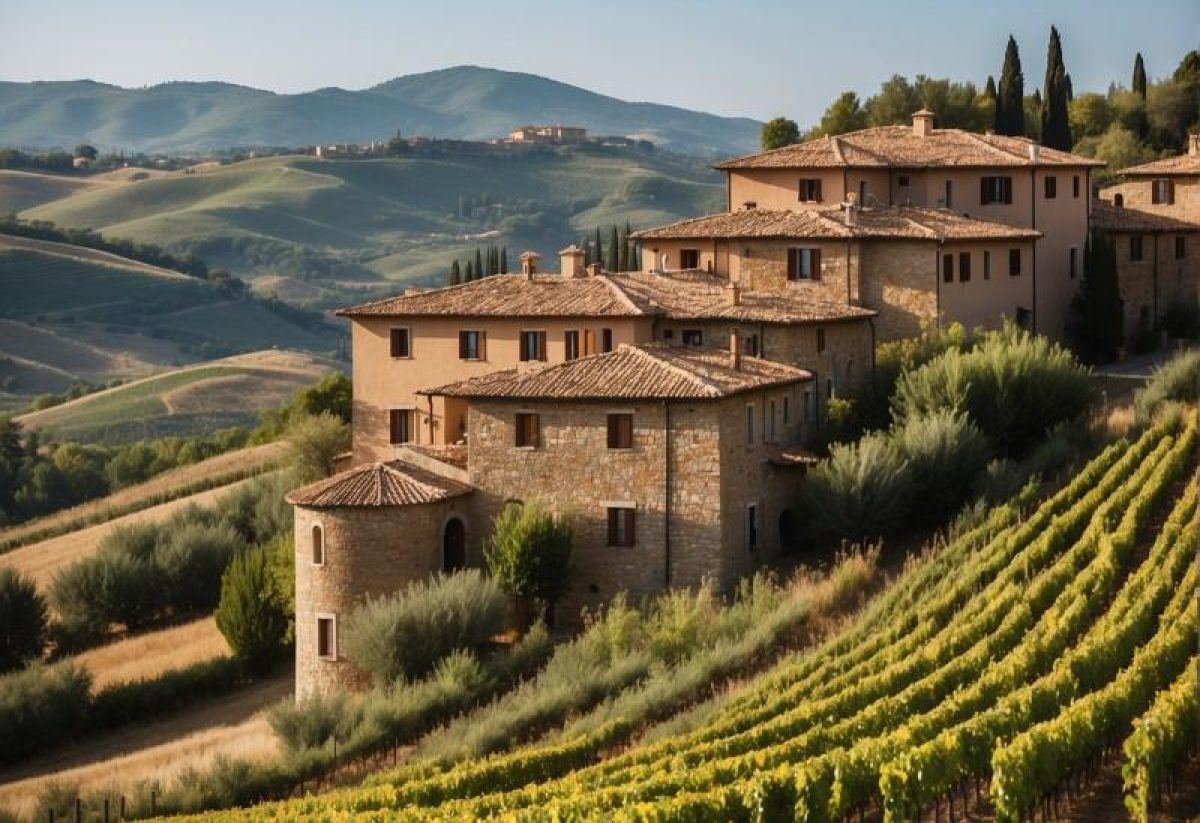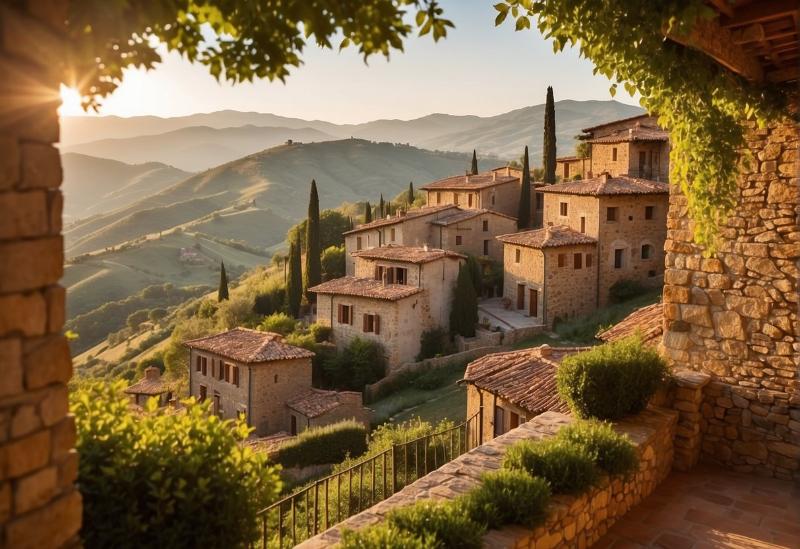Tuscany, with its rolling hills, vineyards, and centuries-old cities, offers a picturesque backdrop for those looking for long-term stays. Apartments in Tuscany provide a blend of rustic charm and modern convenience, appealing to a variety of tastes and preferences. Long-term rentals in the region cater to diverse needs, with properties ranging from cozy, traditional apartments in historic centers to luxurious villas with expansive gardens.

Tuscany’s rental market boasts many options for those seeking a home away from home. Houses and flats are available for rent throughout this storied region of Italy, offering amenities like full kitchens, Wi-Fi, and terrace views overlooking the verdant landscape or the Mediterranean coastline. Renters can immerse themselves in local culture and enjoy the tranquility of the countryside or the vibrant community life in cities like Florence, Siena, and Pisa.
When looking for a property, prospective tenants will find that the Tuscany apartment side’s offerings cater to different budgets and desires for convenience and authentic Italian living. Proximity to historic sites, local markets, and traditional restaurants adds to the allure of renting an apartment in this region. As a hub of art, history, and gastronomy, Tuscany remains an ideal choice for those wanting to settle into the Italian way of life for an extended period.
The Appeal of Tuscany

Tuscany embodies the heart of Italy’s cultural and natural wealth, offering a quintessentially Italian experience. The region’s rolling countryside, dotted with olive groves and vineyards, provides breathtaking views that have captured the imagination of artists and travelers alike.
- Siena and Florence are jewels of Tuscan heritage, renowned for their historical architecture and vibrant local culture.
- San Gimignano stands out with its famous medieval towers, often visible from cozy Tuscan apartments.
- Coastal cities like Livorno and Pisa not only present iconic sites such as the Leaning Tower but also prompt access to the Tyrrhenian Sea’s tranquil beaches.
Tuscan cities are steeped in history, with cobblestone streets leading to bustling piazzas, and the landscape is dotted with fortressed hilltop towns and Renaissance art.
Notable Cities Attractions Siena Piazza del Campo Florence Uffizi Gallery San Gimignano Tower Town Livorno Harbor and Seafront Pisa Leaning Tower
Residents and visitors alike revel in the region’s nature, which ranges from serene countryside to the rugged Apennine Mountains. The climate in Tuscany is generally mild, making it an ideal location for those seeking to enjoy Italy’s beauty year-round.
When choosing an apartment in Tuscany, prospective renters are often swayed by the promise of an authentic Italian lifestyle embraced by Tuscan warmth—where locally sourced food, wine, and the arts are never far from one’s doorstep.
Types of Apartments Available

Tuscany has a diverse range of apartments catering to different needs, from cozy studios to luxurious penthouses. Each offers unique features and amenities to enhance living experiences.
By Size
- Studio: Compact living spaces, often more affordable, suitable for individuals or couples. They typically combine the bedroom, living area, and kitchen into one open space with a separate bathroom.
- One-Bedroom: Ideal for individuals or couples seeking more room than a studio. A one-bedroom apartment includes a separate bedroom, living area, kitchen, and bathroom.
- Two-Bedroom: These apartments provide ample space for small families or roommates, featuring two bedrooms, a living area, a kitchen, and one or more bathrooms.
- Penthouse: The epitome of luxury, offering spacious layouts, premium amenities, often with stunning views and terraces.
By Features
- Furnished: Ready-to-move-in options come with essential furniture, easing the transition for renters.
- Pet-Friendly: Some rentals welcome pets, ensuring you don’t have to part with your furry friends.
- Amenities: Look for apartments with elevators, security, parking, and in-unit laundry for added convenience.
- Special Features: Desirable additions can include a balcony with a view, pool, garden, or terrace to enjoy the Tuscan landscape.
By Location
- City Center: Rentals in city centers like Florence offer the charms of urban living, with cultural attractions and bustling nightlife at your doorstep.
- Tuscan Hills: Those seeking tranquility may prefer apartments nestled in the hills, such as in Chianti, boasting serene landscapes and proximity to vineyards.
- Coastal Areas: Apartments near the coast provide a delightful living experience with sea views and easy beach access.
- Countryside Farmhouses: A rustic choice that reflects the Tuscan heritage, featuring larger living spaces often with gardens and traditional kitchens.
How to Choose the Right Location

When searching for an apartment in Tuscany, identifying the right location is essential. The preference between a vibrant city atmosphere or the tranquil Tuscan countryside sets the stage for your stay. In cities like Florence or Siena, travelers can immerse themselves in rich history and cultural attractions, enjoying the proximity to museums, restaurants, and shopping.
- Cities: Ideal for those who appreciate a lively environment with easy access to amenities.
- Countryside: Perfect for a peaceful retreat, surrounded by picturesque landscapes.
Neighborhoods within the chosen area significantly impact one’s experience. Research is crucial to find areas that resonate with personal preferences and lifestyle. Consider:
- Safety: Prioritize secure neighborhoods.
- Local Amenities: Check for shops, public transport, and health services.
- Visitor Attraction:* Proximity to historic sites or nature reserves.
The destination itself should align with specific interests. Wine enthusiasts may prefer the Chianti region, while beach lovers might gravitate towards the coastal areas like Viareggio.
- Chianti: Known for wineries and gastronomy.
- Coastal Areas: Offer sea views and maritime activities.
Local tips further refine the rental choice. A tourist tax is commonplace, generally 1-2 Euros per night, which should be factored into the budget. Understanding the local community and its offerings can greatly enhance one’s stay, marrying the comfort of home with the excitement of new experiences.
Navigating the Rental Market
Navigating the rental market for modern apartment in Tuscany involves understanding lease contracts and assessing costs against one’s budget. Tenants need to familiarize themselves with rental agreements and consider the financial implications of renting an apartment in this picturesque region of Italy.
Understanding Contracts
When renting an apartment in Tuscany, a tenant should carefully review the lease contract. This binding agreement outlines the tenant and landlord’s obligations and rights. Key components of a lease typically include the rental period, security deposit, payment terms, and conditions for termination of the lease. In Tuscany, it’s common for rental contracts to have a minimum term of 12 months. Tenants should also look for clauses regarding maintenance responsibilities and utilities to ensure no unexpected costs.
Amenities such as furnished or unfurnished options, and proximity to local attractions like markets, historical sites, or natural landscapes, should be considered as they can impact the living experience.
Cost Considerations
When budgeting for an apartment rental in Tuscany, tenants should account for the rent price, security deposit, and any additional utilities not included. The average long-term rental price can range significantly based on location, size, and amenities. For example, properties closer to city centers or tourist spots typically command higher prices.
Tenants should prepare for potential upfront costs, including the first month’s rent and the deposit, which aim to protect the landlord against damages or unpaid rent. Furthermore, a clear understanding of what is included in the rental price, such as furniture, parking, and access to shared facilities like a swimming pool or garden, is crucial for tenants to avoid future disputes and to align the chosen property with their lifestyle and budget.
Living Like a Local: What to Expect
When renting an apartment in Tuscany, tenants are immersed in a vibrant culture steeped in history and tradition. In Tuscan communities, locals value a slower pace of life, where the camaraderie among neighbors plays a central role.
Amenities: Apartments typically blend rustic charm with modern conveniences. Expect well-equipped kitchens, but it’s the living rooms that often boast the quintessential Tuscan character—exposed beams, terracotta floors, and antique furniture.
Lifestyle Considerations:
- Market Days: Most towns have weekly markets; a perfect way to source local produce and mingle with the community.
- Siesta Time: Many shops close in the afternoon for a few hours, adhering to local rest and family time customs.
Community Engagement:
- Festivals: Participate in numerous local festivals often centered around food, wine, and medieval traditions.
- Language: Learning some Italian phrases can help one integrate seamlessly.
Local Life:
- Healthcare and everyday shopping are readily available, especially in larger towns like Florence.
- Public transport is reliable, though many locals prefer walking or cycling through the picturesque streets.
Expect:
- Cultural richness, with art galleries, museums, and historic sites at your doorstep.
- Social warmth, where making connections can be as simple as a daily visit to a local café.
Cultural Highlights and Must-Visits in Tuscany
Tuscany is a treasure trove of cultural experiences, boasting everything from well-preserved historical sites and breathtaking natural landscapes to a rich culinary tradition. Visitors can immerse themselves in diverse activities and attractions that are quintessentially Tuscan.
Historical Sites
Tuscany’s historic fabric is woven with numerous Etruscan and Roman relics, Medieval towns, and Renaissance treasures. Must-visit destinations include the Piazza del Campo in Siena, famous for its annual Palio horse race and connection to the film Quantum of Solace. Florence, the cradle of the Renaissance, offers world-renowned art galleries and architectural marvels. Explorers should not miss the Roman Theatre in Volterra, one of Italy’s best-preserved ancient theaters.
- Siena: Palio horse race, medieval centre
- Florence: Art galleries, architecture
- Volterra: Roman Theatre, Etruscan history
Local Tip: Allocate ample time to wander through the historic center of Siena’s historic centre before the Palio race intensifies the city’s energy.
Natural Beauty
The Tuscan countryside is enveloped in rolling hills and iconic cypress-lined landscapes, offering panoramic vistas that have inspired artists for centuries. In particular, the hills of Chianti present an idyllic setting with their verdant vineyards and olive groves. San Gimignano, with its distinctive skyline of medieval towers, offers a picturesque vantage point to appreciate the region’s natural allure.
- Chianti: Vineyards, olive groves
- San Gimignano: Towering views, countryside
Local Tip: Visit Chianti during the grape harvest for an authentic glimpse into winemaking traditions against a backdrop of stunning scenery.
Culinary Experiences
Tuscany is synonymous with exquisite local cuisine, from rustic trattorias to high-end restaurants. Signature dishes often feature locally grown produce, truffles, and meats like the Cinta Senese. The region is home to renowned wine estates south of Pisa, where visitors can taste world-class wines while gazing out over the vineyards. The wines of the Chianti region are particularly celebrated, perfectly paired with local specialties such as ribollita or bistecca alla fiorentina.
- Local cuisine: Ribollita, bistecca alla fiorentina
- Wine estates: Chianti, Pisa
Local Tip: Seek out family-run establishments where traditional recipes are passed down through generations, ensuring an authentic dining experience.
Seasonal Considerations for Renting
When planning a vacation in Tuscany, prospective renters should be mindful of the changing seasons, as they significantly influence availability, weather, and price fluctuations.
Spring (March to May)
- Availability: Moderate
- Weather: Pleasant; a blend of mild and warm days
- Price Fluctuations: Moderate due to the start of the tourist season
Summer (June to August)
- Availability: More limited as demand surges
- Weather: Hot and dry; ideal for enjoying Tuscany’s beaches and outdoor dining
- Price Fluctuations: Peak prices due to high tourist influx
Autumn (September to November)
- Availability: High as the tourist season winds down
- Weather: Mild; vineyard harvests
- Price Fluctuations: Decrease post-summer with potential for discounts
Winter (December to February)
- Availability: High; quietest season
- Weather: Cooler with occasional rain; less suitable for outdoor activities
- Price Fluctuations: Lowest prices, attractive for budget travelers
Renters should consider that the peak season brings vibrant local festivals and a lively atmosphere. Conversely, off-peak seasons offer a more authentic experience with fewer crowds and the opportunity to enjoy local attractions such as the thermal baths in Saturnia or the wintertime charm of Tuscan villages.
Visitors should also factor local holiday periods into their planning, as they can affect both availability and prices. For instance, the Easter holiday or Christmas might see a spike in rental prices due to local travelers looking for holiday getaways.
Insider Tips for a Smooth Rental Experience
Finding the perfect rental in Tuscany can enrich one’s vacation significantly. The following insights are crafted to ensure a seamless integration into the Tuscan lifestyle while enjoying the comforts of a chosen accommodation.
Communication
Successful rental experiences in Tuscany often hinge on clear communication. Foreign visitors should not assume that every local speaks English. It’s advised to learn basic Italian phrases or use a translation app to facilitate smoother interactions. Renters should also clarify terms regarding the rental period, payment, and any included amenities before arrival to avoid misunderstandings.
- Initial Contact: Send a clear and concise inquiry when booking your stay.
- Amenities Checklist: Confirm the availability of air conditioning, hot tubs, and other specific amenities.
- Emergency Contact: Ensure that you have a local contact number for any urgent needs during your stay.
Adjusting to Local Norms
Guests should familiarize themselves with local customs and daily life to integrate with ease. For instance, respecting etiquette during a wine tasting or understanding the local dining hours can greatly enhance the experience. Be prepared for potential tourist taxes, which can be around 1-2 Euros per night, and factor this into your budget. Embracing the local norms not only enriches one’s stay but also often leads to a warmer reception from the community.
- Tourist Tax: Budget for the local tourist tax as part of your accommodation costs.
- Cultural Etiquette: Research and observe local customs to show respect and ensure a pleasant experience.
Resources for Potential Renters
Various online platforms provide extensive listings for long-term rentals in Tuscany, Italy. They compile offerings from furnished apartments to houses and rooms suitable for extended stays. Prospective renters can explore options on websites such as Idealista and Rentola, which connect them directly with property owners and real estate agents.
Resource Websites:
- idealista: Offers a wide range of apartments and houses with user ratings, helpful for gauging tenant satisfaction.
- Rentola: Lists properties with diverse budget ranges, allowing renters to find economical and premium accommodations.
Prospective tenants should note specific conditions, such as late check-in fees that some hosts might apply. Punctual communication with hosts regarding arrival times is recommended to avoid potential extra costs.
Tips for Renters:
- Compare Listings: Examine multiple sources for the best rates and accommodations that meet your criteria.
- Check Reviews: Look at previous tenant reviews and ratings to assess the quality and reliability of the rental and landlord.
- Understand Fees: Be aware of any additional charges, such as late check-in fees.
Renters are encouraged to inquire about the local attractions and amenities nearby their potential new homes. Such insight can greatly enhance the living experience in Tuscany, which is known for its rich culture and enchanting landscapes.
Frequently Asked Questions
Finding the ideal apartment in Tuscany involves understanding the rental market and what you can expect in terms of pricing, lease terms, and amenities. Here’s what potential renters should know.
What are the average rental prices for apartments in Tuscany?
In Tuscany, monthly rental prices vary widely based on location, property size, and luxury level. A typical one-bedroom apartment in cities like Florence and Siena may range from 500 to 1,200 euros. Rural or less tourist-centric areas may offer lower rates, perfect for those seeking a tranquil setting without sacrificing convenience to local amenities.
How do rental prices in Tuscany compare between short-term and long-term leases?
Short-term apartment leases in Tuscany, aimed at tourists and travelers, often command higher rates due to their flexibility, services, and, often, locations in the heart of historical areas. Conversely, long-term rentals cater to residents looking for stability and can be significantly less expensive, with the potential for negotiated rates for extended stays.
What properties are available for rent in Tuscany outside of traditional apartments?
Aside from standard apartments, Tuscany’s rental market includes rustic farmhouses, villas, and country homes. These properties may be located nestled among vineyards or olive groves, offering a unique experience of the Tuscan landscape and lifestyle, with access to local town centers and an immersive cultural environment.
What amenities and features should I expect from a one-bedroom apartment in Tuscany?
A one-bedroom apartment in Tuscany often features classic Italian architecture, modern conveniences, and sometimes communal spaces like terraces or gardens. Renters should look for functional kitchens, comfortable living spaces, and adequate storage. Apartments in historic centers may boast charming details like exposed beams and stone walls, adding to the house’ Tuscan ambiance.


0 Comment